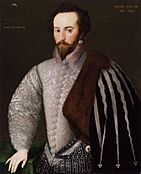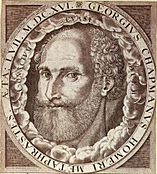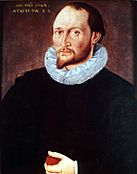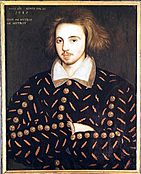The School of Night facts for kids
The School of Night is a modern name for a group of smart men who gathered around Sir Walter Raleigh long ago. In 1592, some people called them the "School of Atheism". This group supposedly included famous writers and scientists like Christopher Marlowe, George Chapman, Matthew Roydon, and Thomas Harriot.
There isn't strong proof that all these men knew each other well. But people often wonder about their connections when they write about the Elizabethan era.
What's in a Name?
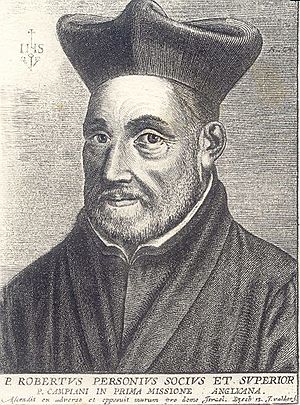
Sir Walter Raleigh's group was first called the "School of Atheism" by a priest named Robert Persons in 1592. The name "School of Night" came much later. It was suggested in 1903 by Arthur Acheson. He thought this group was a secret club for thinkers.
The new name comes from a play by William Shakespeare called Love's Labour's Lost. In the play, a character says, "Black is the badge of hell / The hue of dungeons and the school of night." This line was used to give the group its modern name. However, some old versions of the play have different words for that line.
The part of the play where this line appears is actually just a joke about someone's dark hair. It doesn't seem to be about a secret group at all.
Suspicions of Atheism
It was believed that these men studied science, philosophy, and religion. They were all suspected of atheism. In those days, being accused of atheism was very serious. It was almost like being accused of treason. This is because the English ruler was also the head of the Church of England. So, being against the church meant being against the ruler.
A man named Richard Baines, who was a spy, claimed he heard that Marlowe had "read the Atheist lecture to Sr. Walter Raleigh [and] others." This was just a rumor from a paid informer. It didn't prove the charges of atheism against the group.
The School of Night in Stories
Even though experts don't widely believe in the "School of Night" as a real secret group anymore, it often appears in books and plays.
A play called The School of Night by Peter Whelan was performed in 1992. It was about the friendship between Shakespeare and Christopher Marlowe.
The School of Night also shows up in many novels. These include The Scholars of Night (1988) by John M. Ford and A Dead Man in Deptford (1993) by Anthony Burgess. Other books are Veronica (1996) by Nicholas Christopher, School of the Night (2000) by Judith Cook, and The School of Night (2001) by Alan Wall. More recent books are The School of Night (2010) by Louis Bayard and Shadow of Night (2012) by Deborah Harkness.
There is also a modern group of actors and improvisers called The School of Night. They are inspired by the original idea of these thinkers. They perform shows where they make up plays and poems on the spot. They sometimes pretend to "channel" lost works by Shakespeare.


